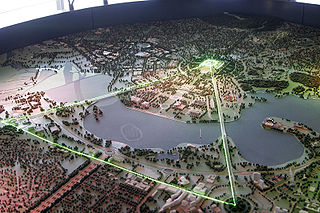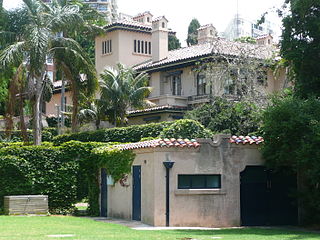
Government House, colloquially known as Yarralumla, is the official residence of the governor-general of Australia. It is located in the suburb of Yarralumla in the Australian capital city of Canberra, in the Australian Capital Territory. The main residence is set amid 54 hectares of parkland. The house and its associated grounds were added to the Commonwealth Heritage List on 22 June 2004.

Yarralumla is a large inner south suburb of Canberra, the capital city of Australia. Located approximately 3.5 km (2.2 mi) south-west of the city, Yarralumla extends along the south-west bank of Lake Burley Griffin from Scrivener Dam to Commonwealth Avenue.

The Australian National Botanic Gardens (ANBG) is a heritage-listed botanical garden located in Acton, Canberra, in the Australian Capital Territory, Australia. Established in 1949, the Gardens is administered by the Australian Government's Department of Agriculture, Water and the Environment. The botanic gardens was added to the Commonwealth Heritage List on 22 June 2004.
Forrest is a suburb of Canberra, Australian Capital Territory, Australia. Forrest is named after Sir John Forrest, an explorer, legislator, federalist, Premier of Western Australia, and one of the fathers of the Australian Constitution. Streets in Forrest are named after explorers and governors. According to the Australian Bureau of Statistics Forrest is the second most Socio-Economic advantaged location in Australia after the neighbouring suburb of Barton.

Barton is a suburb of Canberra, Australian Capital Territory, Australia. At the 2021 census, Barton had a population of 1,946 people.

Griffith is an early inner-south suburb of Canberra, Australian Capital Territory, Australia.

The Norman Lindsay Gallery and Museum is the former residence and farmlet of Australian artist Norman Lindsay. Now an art gallery, tourist attraction and museum located at 14–20 Norman Lindsay Crescent in the Blue Mountains town of Faulconbridge in the City of Blue Mountains local government area of New South Wales, Australia, it was built from 1898 to 1913 by Francis Foy, Patrick Ryan, Lindsay, and the artist's wife, Rose Lindsay. The property, owned by the National Trust of Australia (NSW), is also known as Maryville and Springwood.

Weston Creek is a district in the Australian Capital Territory in Australia. The district is subdivided into divisions (suburbs), sections and blocks. The district comprises eight residential suburbs, situated to the west of the Woden Valley district and approximately 13 kilometres (8.1 mi) southwest of the Canberra City centre. Situated adjacent to the district was the large Stromlo Forest pine plantation until the forest was destroyed by bushfires in 2001 and 2003.

Old Parliament House, formerly known as the Provisional Parliament House, was the seat of the Parliament of Australia from 1927 to 1988. The building began operation on 9 May 1927 after Parliament's relocation from Melbourne to the new capital, Canberra. In 1988, the Commonwealth Parliament transferred to the new Parliament House on Capital Hill. Since 2009, Old Parliament House has become a museum about the building and Australian democracy more broadly, named the Museum of Australian Democracy at Old Parliament House (MoAD). It also serves as a venue for temporary exhibitions, lectures and concerts.

St Vincent Gardens in the Melbourne suburb of Albert Park, is an Australian park of national significance.

The Adelaide Park Lands comprise the figure-eight configuration of land, spanning both banks of the River Torrens between Hackney and Thebarton, which encloses and separates the City of Adelaide area from the surrounding suburbia of greater metropolitan Adelaide, the capital city of South Australia. They were laid out by Colonel William Light in his design for the city, and originally consisted of 2,300 acres (930 ha) "exclusive of 32 acres (13 ha) for a public cemetery". One copy of Light's plan shows areas for a cemetery and a Post and Telegraph Store on West Terrace, a small Government Domain and Barracks on the central part of North Terrace, a hospital on East Terrace, a Botanical Garden on the River Torrens west of North Adelaide, and a school and a storehouse south-west of North Adelaide.

The National Triangle, also known as the Parliamentary Triangle, is the ceremonial precinct of Canberra, containing some of Australia's most significant buildings. The Triangle is formed by Commonwealth, Kings and Constitution Avenues. Buildings within the National Triangle have been located and designed intentionally for visual effect, and those of national significance are popular tourist attractions.

Ainslie is a suburb of Canberra, Australia in the North Canberra district.

Vaucluse House is a heritage-listed residence, colonial farm and country estate and now tourist attraction, house museum and public park, formerly the home of statesman William Charles Wentworth and his family. It is located at 69a Wentworth Road, Vaucluse in the Municipality of Woollahra local government area of New South Wales, Australia. Completed between 1803 and 1839 in the Gothic Revival style, its design was attributed to W. C. Wentworth and built by Sir Henry Browne Hayes and W. C. Wentworth. The property is owned by the Historic Houses Trust of New South Wales, an agency of the Government of New South Wales. The site was added to the New South Wales State Heritage Register on 2 April 1999.

Constitution Place is a park in Canberra, the capital of Australia. The area was named in February 1998 by Prime Minister of Australia John Howard during the course of the Fourth Constitutional Convention on the options for an Australian republic. The park is located to the south-east of Old Parliament House and adjoining the Old Parliament House Gardens and nearby to the National Archives of Australia. It is semicircular in shape, with curved road frontages on King George Terrace, Walpole Crescent and Queen Victoria Terrace. There is also a windbreak of trees, which were planted by Charles Weston as superintendent of parks and gardens in Canberra.

The Ohio Governor's Residence and Heritage Garden is the official residence of the governor of Ohio. The residence was built during 1923–1925 by industrialist Malcolm D. Jeffrey and has served as the official home of the governor since 1957. The mansion is located at 358 North Parkview Avenue in Bexley, a suburb and enclave of the state capital, Columbus. It is only one of four official state governor's residences in the country that is not located within its state's capital.

Boomerang is a heritage-listed private house and garden located at 42 Billyard Avenue in the inner eastern Sydney suburb of Elizabeth Bay, New South Wales, Australia. The house was designed by Neville Hampson and the gardens and grounds by Max Shelley, and built from 1926 to 1928.

Ithaca Embankments is a heritage-listed group of embankments in the former Town of Ithaca and now in the suburbs of Kelvin Grove, Red Hill and Paddington in Brisbane, Queensland, Australia. They were designed by Alexander Jolly and built from c. 1917 to c. 1923. They were added to the Queensland Heritage Register on 2 March 1993.

Robert Arthur Broinowski was an Australian public servant. He served as clerk of the Australian Senate from 1939 to 1942.




















